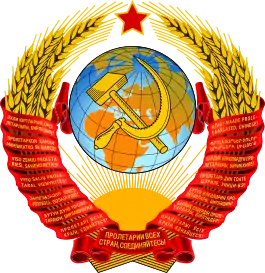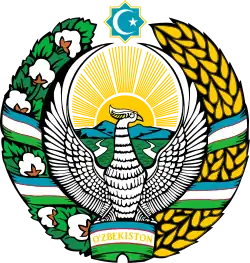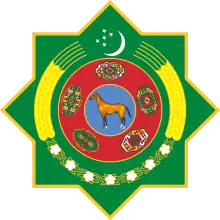Khorezm People's Soviet Republic
The Khorezm People's Soviet Republic (Uzbek: Xorazm Xalq Sovet Respublikasi; Russian: Хорезмская Народная Советская Республика, tr. Khorezmskaya Narodnaya Sovetskaya Respublika) was the state created as the successor to the Khanate of Khiva in February 1920, when the Khan abdicated in response to pressure and officially declared by the First Khorezm Kurultay (Assembly) on 26 April 1920. On 20 October 1923, it was transformed into the Khorezm Socialist Soviet Republic (Russian: Хорезмская ССР, tr. Khorezmskaya SSR).[1]
.jpg.webp)
Khorezm People's Soviet Republic | |||||||||||||
|---|---|---|---|---|---|---|---|---|---|---|---|---|---|
| 1920–1924 | |||||||||||||
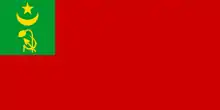 Flag
.svg.png.webp) Emblem (1922–23)
.svg.png.webp) | |||||||||||||
.svg.png.webp) The Khorezm People's Soviet Republic in 1922 | |||||||||||||
| Capital | Khiva | ||||||||||||
| Common languages | Uzbek | ||||||||||||
| Religion | |||||||||||||
| Government | Socialist republic | ||||||||||||
| Chairman | |||||||||||||
• 1920-1921 (first) | Palvanniyaz Khodzhi Yusupov | ||||||||||||
• 1924 (last) | Sultan-Kary Dzhumaniyazov | ||||||||||||
| Historical era | Interwar period | ||||||||||||
• Abdication of Sayid Abdullah | 2 February 1920 | ||||||||||||
• Republic established | 26 April 1920 | ||||||||||||
• Part of USSR | 27 October 1924 | ||||||||||||
| |||||||||||||
| Today part of | Turkmenistan Uzbekistan Kazakhstan | ||||||||||||
On 27 October 1924 the Khorezm SSR was divided between Uzbek and Turkmen SSRs and the Karakalpak Autonomous Oblast as part of the delimitation of Central Asia according to nationalities.[2]
Politics
Chairman of the Revolutionary Committee
- Mulla Dzhumaniyaz Sultanmuradov (2 February 1920 – 26 April 1920)
Chairmen of the Presidium of the Assembly (Kurultoy) of People's Representatives
- Palvanniyaz Khodzhi Yusupov (26 April 1920 – 6 March 1921)
- Dzhabbarbergen Kuchkarov (6 March 1921 – 15 May 1921; continues as supreme authority to 23 May 1921)
- Khudaybergen Divanov (15 May 1921 – 23 May 1921)
Chairmen of the Presidium of the Central Executive Committee
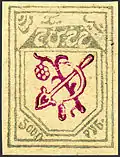
- Madrakhim Allabergenov (23 May 1921 – 5 September 1921)
- Mulla Ata-Maksum Madrakhimov (5 September 1921 – 27 November 1921)
- Yangibay Muradov (27 November 1921 – 23 July 1922)
- Abdulla Khodzhayev "Khadzhi Baba" (23 July 1922 – 20 October 1922)
- Atadzhan Safayev (20 October 1922 – 26 March 1923)
- Abdulla Khodzhayev "Khadzhi Baba" (March 1923 – 20 October 1923)
- Karim Safayev (20 October 1923 – 26 March 1924)
- Mukhamed Abdusalyamov (17 January 1924 – 19 February 1924) (acting)
- Sultan-Kary Dzhumaniyazov (26 March 1924 – 17 September 1924)
- Nedirbay Aytakov (17 September 1924 – 27 October 1924)
- Sultan-Kary Dzhumaniyazov (October 1924 – 23 November 1924)
Geography
The Khorezm People's National Republic bordered on the Turkestan Autonomous Soviet Socialist Republic to the north and to the south, and on the Bukharan People's Soviet Republic to the east. Its western border was a rough continuation of the western coast of Aral Sea, bordering on what was then the Kirghiz ASSR (today's western Kazakhstan). It had an area of 62,200 km2 (24,000 sq mi) and a population of more than 600,000 people, mainly Uzbeks (62.5%), Turkmens (28.6%), Kazakhs (3.5%), and Karakalpaks (3.0%). Its capital was Khiva.[1]
References
- Khorezm People's Soviet Republic: Big Soviet Encyclopedia on-line edition. (in Russian)
- Погорельский И.В. История Хивинской революции и Хорезмской народной советской республики 1917–1924 гг., Ленинград: Изд-во ЛГУ, 1984
